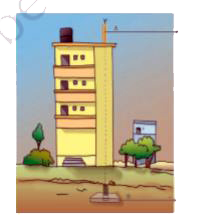What is lightning conductor?
Step-by-Step Text Solution:
1. Definition of Lightning Conductor: A lightning conductor is a device designed to protect tall structures, such as buildings and trees, from the damaging effects of lightning strikes.
2. Components of a Lightning Conductor: The main components of a lightning conductor include:
- Lightning Rod: This is a metal rod placed at the highest point of the structure. It is the part that directly intercepts the lightning strike.
- Connecting Wire: A wire connects the lightning rod to the ground. This wire is crucial as it provides a path for the lightning's electrical charge to travel safely to the ground.
- Ground Rod: This is a metal rod buried in the ground, which helps in dispersing the electrical charge safely into the earth.
3. How It Works:
- When lightning strikes a tall building, the lightning rod captures the electrical charge.
- The charge travels down the connecting wire to the ground rod.
- The ground rod disperses the charge into the earth, which can absorb large amounts of electrical energy without harm.
4. Purpose: The primary purpose of a lightning conductor is to prevent damage to structures and ensure safety by directing the electrical charge away from the building and into the ground.
- Lightning Rod: This is a metal rod placed at the highest point of the structure. It is the part that directly intercepts the lightning strike.
- Connecting Wire: A wire connects the lightning rod to the ground. This wire is crucial as it provides a path for the lightning's electrical charge to travel safely to the ground.
- Ground Rod: This is a metal rod buried in the ground, which helps in dispersing the electrical charge safely into the earth.
- When lightning strikes a tall building, the lightning rod captures the electrical charge.
- The charge travels down the connecting wire to the ground rod.
- The ground rod disperses the charge into the earth, which can absorb large amounts of electrical energy without harm.
Topper's Solved these Questions
- SOME NATURAL PHENOMENABook:PEARSON IIT JEE FOUNDATIONChapter:SOME NATURAL PHENOMENAExercise:Track Your Learning-I
Explore 9 Videos
- SOME NATURAL PHENOMENABook:PEARSON IIT JEE FOUNDATIONChapter:SOME NATURAL PHENOMENAExercise:Track Your Learning-II
Explore 5 Videos
- SOME IMPORTANT ELEMENTS AND THEIR COMPOUNDSBook:PEARSON IIT JEE FOUNDATIONChapter:SOME IMPORTANT ELEMENTS AND THEIR COMPOUNDSExercise:Level-3
Explore 10 Videos
- SYNTHETIC FIBRES AND PLASTICS Book:PEARSON IIT JEE FOUNDATIONChapter:SYNTHETIC FIBRES AND PLASTICS Exercise:COMPETITION CORNER (Choose the correct option)
Explore 53 Videos
Similar Questions
Knowledge Check
Who invented the lightning conductor?
AEdward PriestlyBVint CerfCBenjamin FranklinDJohn DaltonDuring lightning, which of these structures would most benefit from a lightning conductor?
AA 40-storey buildingBA one-storey houseCA small treeDA gardenWhich material is used to make lightning conductors?
AWoodBGlassCCopperDPlastic
Identify the lightning conductor and the copper plate in Fig. 15.2.

View SolutionDefine lightning conductor.
View SolutionTo protect tall buildings from damage by lightning a lightning conductor is find on them. A lightning conductor consists of a metal rod ending in spikes at the top. The lower end of the rod is attached to a copper plate buried deep in the earth. If lightning does strike the building, it flows harmlessly to the earth through the metal rod, and no damage is done to the building
Who developed the idea of using lightning conductors to protect tall buildings?
View SolutionTo protect tall buildings from damage by lightning a lightning conductor is find on them. A lightning conductor consists of a metal rod ending in spikes at the top. The lower end of the rod is attached to a copper plate buried deep in the earth. If lightning does strike the building, it flows harmlessly to the earth through the metal rod, and no damage is done to the building
Which metal can be used, instead of copper to make plate, which is buried deep in the earth?
View SolutionWhich shape is best suited for a lightning conductor?
View Solution
